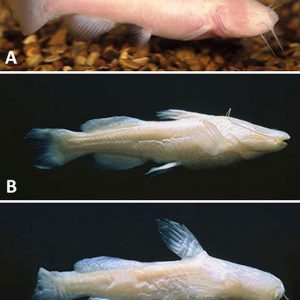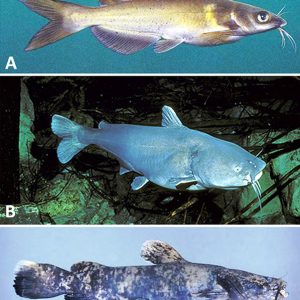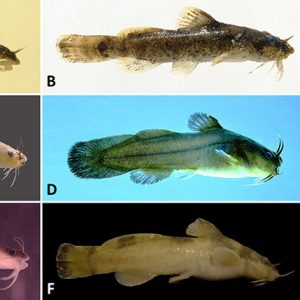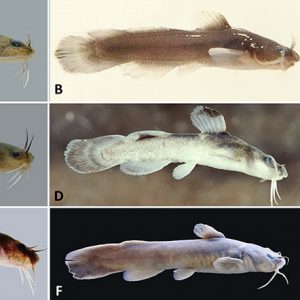calsfoundation@cals.org
Ictaluridae
aka: Catfishes
aka: Bullheads
aka: Madtoms
The Ictaluridae is a family of North American native fishes belonging to the Class Siluriformes. The Ictaluridae family also belongs to the Superorder Ostariophysi, the second-largest superorder of fish. This diverse group, present on all continents except Antarctica, contains 10,758 species—more than twenty-eight percent of known fish species in the world and seventy-two percent of all freshwater species. The family proper includes about seven genera and fifty-one species, some commonly known as bullheads, catfishes, and madtoms. As such, it is the largest family of freshwater fishes endemic to North America. In Arkansas, they are easily recognized as the only fishes in the state with four pairs (two on the snout, two on the end of maxillae, and four on the chin) of conspicuous barbels around the mouth. Members of this family were originally distributed in most states east of the Rocky Mountains, but various species have been widely introduced into western states. The entire range of the family is now from southern Canada to Guatemala. They are important as food fish, and several of the larger species are regarded as sport fishes, especially the widely marketed channel catfish (Ictalurus punctatus), the most important species of aquatic animal commercially cultured in the United States.
In the fossil record, the family dates to the Paleocene, and representatives of some present-day genera are known from the Oligocene. The Ictaluridae is strongly supported as a monophyletic group. It is closely related to the Asian fish family Cranoglanididae (armored catfishes). These two families are sister taxa in the superfamily Ictaluroidea. Ictalurids are classified among ostariophysan fishes (including also minnows and suckers, plus several other groups of primarily freshwater fishes from many parts of the globe) by virtue of the presence of a Weberian apparatus. Though the family includes three genera of blind, subterranean, and troglobitic catfishes (Prietella, Satan, and Trogloglanis), none of these three genera are closely related. Instead, Satan is closely related to flatheads (Pylodictis), Prietella to madtoms (Noturus), and Trogloglanis possibly to catfishes (Ictalurus), although it may not be closely related to any of the other ictalurids. The bullheads (Ameiurus) are sister to a clade formed by Noturus, Prietella, Pylodictis, and Satan.
Ictalurids are very easy to recognize from other North American freshwater fishes. The general morphological characteristics of extant members of the family are a head with four pairs of sensory barbels commonly called “whiskers”—two nasal, two maxillary, and four chin. The mouth is relatively large, there are no palatine teeth, and their skin is scaleless. They have three median fins: anal, adipose, and dorsal with six soft rays. A single sharp stout spine (actually groups of fused rays) is situated on the anterior edge of the dorsal fin (except in Prietella) and pectoral fins. The madtoms (Noturus spp.) are especially noted for having venom (poison) glandular cells in the skin surrounding these spines that are capable of inflicting a painful, but not dangerous, wound. Reaction to the “sting” of a madtom varies with the individual but is generally considered equivalent to a bee sting. However, abscess formation and cellulitis in the setting of envenomation have been reported as complications of handling catfish. In very rare cases, significant morbidity may result, including severe pain, infection, retained foreign bodies, respiratory compromise, arterial hypotension, and cardiac dysrhythmias. The anal fin has a long base and is located on the underside of the fish. The adipose fin is a small, fatty fin situated between the dorsal fin and the tail. Also present are two sets of paired fins: the pelvic and pectoral. They have a well-developed Weberian apparatus, an anatomical structure that connects the swim bladder to the auditory system.
Weight of ictalurids varies tremendously, from the relatively tiny madtoms that weigh only few grams or less and typical bullheads that often weigh less than 0.5 kg (1 lb.) to the massive blue catfish that can weigh over 50 kg (110 lbs.).
Ictalurids are generally warmwater “bottom feeders” with widely varied diets; they also scavenge. Members of this family are active mainly at night foraging but also feeding during the day in turbid waters, using their sensory barbels to feed on various insects, worms, and crustaceans, but primarily fish (especially shad). Juveniles primarily feed on aquatic insects and small fish.
In terms of reproduction, ictalurids have apparently evolved considerably as social animals. For example, the yellow bullhead is a very social fish that can recognize, by their smell, other individuals and even their social status. All ictalurids for which breeding behavior is known build nests and provide parental protection for the eggs and young. Important nesting sites for the catfishes and bullheads include natural cavities under overhanging banks in rivers and reservoirs, but bullheads often nest in open areas. Spawning occurs from spring to early summer in the various species. While both parents may contribute to nest site selection and construction plus guarding of eggs and young, parental care is often a strictly male function. Nuptial males develop swollen lips and dorsal head musculature, and typically do not feed during nesting.
Freshwater Catfishes (genus Ictalurus)
In Arkansas, this group includes the blue catfish (I. furcatus) and the more familiar channel catfish (I. punctatus), which is native to the Nearctic, being well distributed in lower Canada and the eastern and northern United States, as well as parts of northern Mexico. They have also been introduced into some watersheds of landlocked Europe (Czech Republic and Romania) and parts of Malaysia and Indonesia. Channel catfish are most abundant in large streams, rivers, lakes, and reservoirs with low to moderate current. This fish is widely marketed and is of angling, aquacultural, and major commercial value. The commercial aquaculture of channel catfish was first considered to be economically practical in the late 1950s, and catfish farming developed rapidly during the 1960s and 1970s. Leading commercial-catfish-producing states are Alabama, Arkansas, Louisiana, and Mississippi. In Arkansas, forty-nine catfish farms produced almost $28 million in sales of I. punctatus in 2013. Many small I. punctatus (termed “fiddlers”) are stocked into private ponds and lakes and often are available for people to catch either free or for a fee. Since channel catfish are omnivores, they can be caught using a variety of natural and prepared baits, including crickets, nightcrawlers, crawfish, chicken liver, and minnows. One common technique used for prepared baits is using soured grains like milo or wheat or range cubes as chum. The state record channel catfish was caught in 1989 from Lake Ouachita (Garland County) and weighed 17.2 kg (38 lbs.).
The blue catfish is native to major rivers of the Missouri, Ohio, and Mississippi river basin with a range extending south through Texas, Mexico, and into northern Guatemala. It is an important part of the fish fauna of Arkansas and is primarily a large-river fish, occurring in main channels, oxbow lakes, tributaries, and impoundments of major river systems. They mainly occur in clear swift waters over sand, gravel, or rocky bottoms. It has been stocked by the Arkansas Game and Fish Commission (AGFC) into the larger reservoirs throughout the state. It is prized by anglers for its fighting ability and large size, and, in addition to being caught by conventional methods, it can also be caught by trotline baited with fish. The state record blue catfish was caught in 2001 from the Mississippi River and weighed 53 kg (116 lbs., 12 oz.). Like I. punctatus, the blue catfish is considered an excellent food fish. Interestingly, an unusual adult male (475 mm standard length) I. furcatus that lacked a caudal peduncle and fin was collected on a trot-line from Lake Overcup (Conway County).
Often, large I. punctatus and medium-sized I. furcatus can be more difficult to tell apart, as they are often similar in color and general body shape. However, I. furcatus can be distinguished from I. punctatus by the following characteristics: (1) smaller eyes situated more anteriorly; (2) a longer and straighter margin on the anal fin; (3) a median keel-like crest anterior to the dorsal fin; (4) a crest on the dorsal edge of the opercle; (5) the sides lacking dark spots; and (6) a higher number of anal rays (I. furcatus usually has more than 32 [30 to 35] versus 25 to 28 in I. punctatus).
Bullhead Catfishes (genus Ameiurus)
There are four species of bullheads in the state: white bullhead (A. catus), black bullhead (A. melas), yellow bullhead (A. natalis), and brown bullhead (A. nebulosus). The black is found statewide in Arkansas and, like the brown and yellow bullhead, is found in silty water and soft muddy bottoms and avoids cold, clear water with strong currents. It may often be found in farm ponds. Since A. melas is often small, it is less popular with anglers than the brown or yellow bullhead, although it is still considered a good food fish. State record bullhead weights are a black bullhead caught in 1986 from Point Remove Creek (Conway County) weighing 2.2 kg (4 lbs., 12 oz.); a yellow bullhead caught in a private lake in 2014 weighing 1.1 kg (2 lbs., 7 oz.); and a brown bullhead caught in the Upper White Oak Lake (Ouachita County) in 2013 weighing 1.4 kg (3 lbs., 3 oz.).
The white bullhead was originally native to the coastal river systems of the eastern United States but was introduced into Arkansas lakes and ponds; apparently, there are no established reproducing populations in the state. As of 1988, I. catus recorded from the state have come from Bodcau Bayou, the Illinois River, Lake Conway/Point Remove, Lower Ouachita River at Smackover (Union County), Lower White River at Bayou Des Arc, and Upper Saline.
The yellow bullhead differs from the black bullhead by possessing white chin barbels (versus black barbels). It is the most widely distributed catfish in the state, only behind I. punctatus. The brown bullhead (with dark pigmented chin barbels) is distributed sporadically in Arkansas and is very uncommon in the state. Although considered native, it had been stocked by the AGFC into several impoundments, and a stable, reproducing population of this bullhead with individuals approaching 1.8 kg (4 lbs.) appears to exist in Sugarloaf Lake (Sebastian County).
Flathead (genus Pylodictis)
The flathead catfish (Pylodictis olivaris), also called mudcat or opelousa catfish, is also important to commercial and sport fishers in Arkansas. It ranges from the lower Great Lakes region to northern Mexico; however, it has been widely introduced and has become an invasive species in some areas. It is found in the state in a variety of habitats; it is most abundant in large sandy-bottomed, turbid rivers (like the Arkansas), where it inhabits deep pools adjacent to strong current or in moderate currents of these sites. Large numbers are caught in hoop nets by commercial fishers and anglers using rod and reel, limb lines, or bare hands (“noodling”). More large individuals of this catfish are caught than any other catfish species in the state. The state record flathead catfish was caught in the Arkansas River in 1989 and weighed 36.3 kg (80 lbs.).
Madtoms (genus Noturus)
Madtoms are the smallest members of the family, and mature individuals weigh only a few ounces (< 1 lb.) and range from 70 to 305 mm (2.7 to 12 in.) in length. Twelve species occur in Arkansas: Ozark madtom (N. albater), mountain madtom (N. eleutherus), slender madtom (N. exilis), checkered madtom (N. flavater), stonecat (N. flavus), tadpole madtom (N. gyrinus), Ouachita madtom (N. lachneri), brindled madtom (N. miurus), freckled madtom (N. nocturnus), brown madtom (N. phaeus), northern madtom (N. stigmosus), and Caddo madtom (N. taylori). The most uncommon of these is N. phaeus, which has only been reported from a single locality in the Ouachita River drainage at Horsehead Creek (Columbia County) in 1972.
Two madtoms are endemic to Arkansas: the Ouachita Madtom and the Caddo Madtom. The stonecat is the largest madtom, with a maximum length of 305 mm (12 in.). Stonecats differ from typical madtoms by having a protruding upper jaw and a slight notch in their caudal fin. They are usually found under or among rocks in the swift water of streams, especially in riffle areas. They also are found in weedy water near shore or in the mud at the mouth of streams. In Arkansas, they are uncommon, and there are only a few reports of specimens from the turbid Mississippi River over a sand bottom in Mississippi and Phillips counties.
Diseases and Parasites
Catfishes are susceptible to many diseases, particularly those that occur as a result of catfish production. Production practices lead to the emergence of infectious diseases as the primary limiting factor in catfish production, and disease outbreaks are not rare, even on well-managed facilities. Indeed, it has been estimated that about forty-five percent of inventory losses on catfish fingerling farms are attributable to infectious diseases. In addition, approximately sixty percent of those are the result of single or mixed bacterial infections (Aeromonas, Edwardsiella, and Flavobacterium), thirty percent result from parasitic infestation (various protozoans, white spot disease, and the trematode Bolbophorus), nine percent are from fungal infections (winter fungus and branchiomycosis), and one percent is considered of viral etiology (channel catfish virus disease [CCVD] and herpesviruses). When these occur as multiple or mixed infections in pond-raised channel catfish, treatment decisions are often difficult. Infectious diseases are believed to cost producers many millions of dollars in direct fish losses each year and directly influence profitability by increasing treatment costs, reducing food consumption by fish, increasing feed conversion ratios, and causing harvesting delays.
A wide variety of parasites have been reported from ictalurids. In Arkansas, an assortment of parasites as well as a new species of trematode (Plagioporus) have been documented in N. lachneri. In addition, various trematode parasites have been reported in N. exilis and N. maydeni, including Alloglossidium spp. in various catfishes. Gill parasites (Ligictaluridus) have been found on various ictalurids from Arkansas and Oklahoma. Fish lice (Argulus) have been found on a flathead catfish and various helminths in catfishes from Lake Texoma from Oklahoma.
For additional information:
Buchanan, Thomas M. Key to the Fishes of Arkansas. Little Rock: Arkansas Game and Fish Commission, 1973.
Cloutman, Donald G., Chris T. McAllister, and Henry W. Robison. “Species of Ligictaluridus (Monogenoidea: Dactylogyridae) Parasitizing Large Catfishes (Siluriformes: Ictaluridae) from Arkansas, Oklahoma, and Texas.” Proceedings of the Oklahoma Academy of Science 98 (2018): 66‒72.
Douglas, Neil H. The Fishes of Louisiana. Baton Rouge: Claitor’s Publishing Division, 1974.
———. “Noturus taylori, a New Species of Madtom (Pisces: Ictaluridae) from the Caddo River, Southwest Arkansas.” Copeia 1972 (1972): 785–789.
Ferraris, Carl J., Jr. “Checklist of Catfishes, Recent and Fossil (Osteichthyes: Siluriformes), and Catalogue of Siluriform Primary types.” Zootaxa 1418 (2007): 1‒628.
Etnier, David A., and Wayne C. Starnes. The Fishes of Tennessee. Knoxville: University of Tennessee Press, 1993.
Fayton, Thomas J., Chris T. McAllister, Henry W. Robison, and Matthew B. Connior. “Two New Species of Plagioporus (Digenea: Opecoelidae) from the Ouachita Madtom, Noturus lachneri, and the Banded Sculpin, Cottus carolinae, from Arkansas.” Journal of Parasitology 104 (2018): 145‒156.
Ferraris, C. J., Jr. “Checklist of Catfishes, Recent and Fossil (Osteichthys: Siluriformes), and Catalogue of Siluriform Primary Types.” Zootaxa 1418 (2007): 1‒628.
Fiorillo, R. A., R. B. Thomas, M. L. Warren, and Christopher M. Taylor. “Structure of the Helminth Assemblage of an Endemic Madtom Catfish (Noturus lachneri).” Southwestern Naturalist 44 (1999): 522–526.
Gagen, Charles J., Robert W. Standage, and J. N. Stoeckel. “Ouachita Madtom (Noturus lachneri) Metapopulation Dynamics in Intermittent Ouachita Mountain Streams.” Copeia 1998 (1998): 874–882.
Hoffman, Glenn L. Parasites of North American Freshwater Fishes. 2nd ed. Berkeley: University of California Press, 2009.
Kasl, Emily L., Chris T. McAllister, Henry W. Robison, Matthew B. Connior, William F. Font, and Charles D. Criscione. “Evolutionary Consequence of a Change in Life Cycle Complexity: a Link Between Precocious Development and Evolution Towards Female-Biased Sex Allocation in a Hermaphroditic Parasite.” Evolution 69 (2015): 3156–3170.
McAllister, Chris T., Charles R. Bursey, Henry W. Robison, Matthew B. Connior, and Stanley E. Trauth. “New Records of Helminth Parasites (Trematoda, Cestoda, Nematoda) from Fishes in the Arkansas and Red River drainages, Oklahoma.” Proceedings of the Oklahoma Academy of Science 96 (2016): 83‒92.
McAllister, Chris T., Charles R. Bursey, Henry W. Robison, David A. Neely, Matthew B. Connior, and Michael A. Barger. “Miscellaneous Fish Helminth Parasite (Trematoda, Cestoidea, Nematoda, Acanthocephala) Records from Arkansas.” Journal of the Arkansas Academy of Science 68 (2014): 78–86. Online at https://scholarworks.uark.edu/cgi/viewcontent.cgi?article=1226&context=jaas (accessed January 10, 2020).
McAllister, Chris T., Anindo Choudhury, Donald G. Cloutman, Stanley E. Trauth, and Henry W. Robison. “Parasites (Cnidaria, Trematoda, Cestoda, Nematoda, Crustacea) of Select Fishes (Lepisosteidae, Catostomidae, Hiodontidae, Cyprinidae, Ictaluridae) of Lake Texoma, Oklahoma.” Proceedings of the Oklahoma Academy of Science 98 (2018): 90‒100.
McAllister, Chris T., William F. Font, Matthew B. Connior, Henry W. Robison, Nicholas G. Stokes, and Charles D. Criscione. “Trematode Parasites (Digenea) of the Slender Madtom, Noturus exilis and Black River Madtom, Noturus maydeni (Siluriformes: Ictaluridae) from Arkansas, U.S.A.” Comparative Parasitology 82 (2015): 137‒143.
McAllister, Chris T., and James T. McAllister, Jr. “An Unusual Blue Catfish, Ictalurus furcatus (Siluriformes: Ictaluridae), from Arkansas.” Texas Journal of Science 40 (1988): 361‒363.
McAllister, Chris T., William J. Poly, Donald G. Cloutman, Henry W. Robison, and Michael K. Hill. “Argulus spp. (Crustacea: Branchiura) on Fishes from Arkansas and Oklahoma: New Geographic Distribution Records.” Proceedings of the Oklahoma Academy of Science 96 (2016): 70‒72.
Miller, Rudolph J., and Henry W. Robison. Fishes of Oklahoma. Norman: University of Oklahoma Press, 2004.
Page, Lawrence M., and Brooks M. Burr. Peterson Field Guide to Freshwater Fishes of North America North of Mexico. 2nd ed. Boston: Houghton Mifflin Harcourt, 2011.
Patton, Tim M., and M. L. Zornes. “An Analysis of Stomach Contents of the Ouachita Madtom (Noturus lachneri) in Three Streams of the Upper Saline River Drainage, Arkansas.” Proceedings of the Arkansas Academy of Science 45 (1991): 78–80. Online at https://scholarworks.uark.edu/cgi/viewcontent.cgi?article=2131&context=jaas (accessed January 10, 2020).
Pflieger, William L. The Fishes of Missouri. Jefferson City: Missouri Department of Conservation, 1997.
Robison, Henry W. “First Record of the Ictalurid Catfish, Noturus phaeus, from Arkansas.” Southwestern Naturalist 18 (1974): 475.
______. “Noturus lachneri Taylor, Ouachita Madtom.” In Atlas of North American Freshwater Fishes, edited by D. S. Lee et al. Raleigh: North Carolina State Museum of Natural History, 1980.
———. “Noturus taylori Douglas, Caddo Madtom.” In Atlas of North American Freshwater Fishes, edited by D. S. Lee et al. Raleigh: North Carolina State Museum of Natural History, 1980.
Robison, Henry W., and Thomas M. Buchanan. Fishes of Arkansas. 2nd ed. Fayetteville: University of Arkansas Press, 2020.
Robison, Henry W., and George L. Harp. “Distribution, Habitat, and Food of the Ouachita Madtom (Noturus lachneri Ictaluridae), a Ouachita River Endemic.” Copeia 1985 (1985): 216–220.
Robison, Henry W., and John L. Harris. “Notes on Habitat and Zoogeography of Noturus taylori (Pisces: Ictaluridae).” Copeia 1978 (1978): 548–550.
Robison, Henry W., and Kenneth L. Smith. “The Endemic Flora and Fauna of Arkansas.” Proceedings of the Arkansas Academy of Science 36 (1982): 50–54. Online at https://scholarworks.uark.edu/cgi/viewcontent.cgi?article=2572&context=jaas (accessed January 10, 2020).
Sadler, J., and Andrew Goodwin. Disease Prevention on Fish Farms. Southern Regional Aquaculture Center Publication No. 4703, 2007.
Stoeckel, Joseph N., Charles J. Gagen, and Robert W. Standage. “Feeding and Reproductive Biology of the Ouachita Madtom.” In Conservation, Ecology, and Management of Catfish: The Second International Symposium, edited by P. H. Michaletz and V. H. Travnichek. Bethesda, MD: American Fisheries Society, 2011.
Tucker, Craig S., and John Hargreaves, eds. Biology and Culture of Channel Catfish. San Diego, CA: Elsevier Publishing Company, 2004.
Tumlison, Renn, and J. O. Hardage. “Growth and Reproduction in the Ouachita Madtom (Noturus lachneri) at the Periphery of its Distribution.” Journal of the Arkansas Academy of Science 68 (2014): 110–116. Online at https://scholarworks.uark.edu/cgi/viewcontent.cgi?article=1231&context=jaas (accessed January 10, 2020).
Tumlison, Renn, and Creed Tumlison. “A Survey of the Fishes in Streams Draining the Jack Mountain Area, Hot Spring and Garland Counties, Arkansas, with Notes on the Ouachita Madtom (Noturus lachneri).” Proceedings of the Arkansas Academy of Science 50 (1996): 154–159. Online at. https://scholarworks.uark.edu/cgi/viewcontent.cgi?article=1869&context=jaas (accessed January 10, 2020).
Turner, Thomas T., and Henry W. Robison. “Genetic Diversity of the Caddo Madtom, Noturus taylori, with Comments on Factors that Promote Genetic Divergence in Fishes Endemic to the Ouachita Highlands.” Southwestern Naturalist 51 (2006): 338–345.
Chris T. McAllister
Eastern Oklahoma State College
 Science and Technology
Science and Technology Bullhead Catfishes of Arkansas
Bullhead Catfishes of Arkansas  Cave Catfishes of Arkansas
Cave Catfishes of Arkansas  Large Catfishes of Arkansas
Large Catfishes of Arkansas  Madtoms
Madtoms  Madtoms
Madtoms 



Comments
No comments on this entry yet.